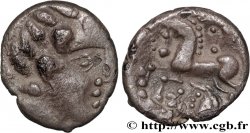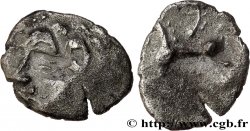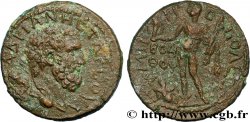bga_530299 - GALLIEN - LEMOVICES (Region die Limoges) Statère à la grue, en argent / billon
Nicht verfügbar.
Artikel auf unserem Online-Shop verkauft (2021)
Preis : 1 125.00 €
Artikel auf unserem Online-Shop verkauft (2021)
Preis : 1 125.00 €
Type : Statère à la grue, en argent / billon
Datum: c. 100-50 BC.
Name der Münzstätte / Stadt : Limoges (87)
Metall : Silber
Durchmesser : 16,5 mm
Stempelstellung : 12 h.
Gewicht : 4,91 g.
Seltenheitsgrad : INÉDIT
Kommentare zum Erhaltungszustand:
Très bel exemplaire avec un joli revers complet et bien centré. Manque de métal au droit à 12h. Patine de collection ancienne
N° im Nachschlagewerk :
Vorderseite
Titulatur der Vorderseite ANÉPIGRAPHE.
Beschreibung Vorderseite Tête à droite, la chevelure en grosses mèches aquitaniques, l’oreille marquée.
Rückseite
Titulatur der Rückseite ANÉPIGRAPHE.
Beschreibung Rückseite Cheval à droite, une grue posée sur la croupe entre deux annelets pointés ; un trèfle entre les jambes.
Kommentare
Avec un flan de 5 mm d’épaisseur et un métal très fortement chargé en argent, cette monnaie se distingue des frappes en or et en bronze ; si le style de flan correspond aux monnaies en bronze, cet exemplaire en billon ou en argent semble être sans équivalent et manquer aux ouvrages de références !
Le motif d‘accolade partant de la bouche (hors flan sur cet exemplaire) devant le visage, est parfois interprété comme le signe de la parole ; on retrouve ce détail sur les statères des Bituriges, mais aussi sous forme des deux dauphins, plus ou moins stylisés, sur la plupart des monnaies d’argent du sud, dites “à la croix”.
With a 5 mm thick flan and a metal heavily loaded with silver, this coin stands out from the gold and bronze strikes; if the flan style corresponds to the bronze coins, this example in billon or silver seems to be without equivalent and missing from reference works! The brace motif starting from the mouth (off flan on this example) in front of the face, is sometimes interpreted as the sign of speech; we find this detail on the staters of the Bituriges, but also in the form of the two dolphins, more or less stylized, on most of the silver coins of the south, called “with the cross”
Le motif d‘accolade partant de la bouche (hors flan sur cet exemplaire) devant le visage, est parfois interprété comme le signe de la parole ; on retrouve ce détail sur les statères des Bituriges, mais aussi sous forme des deux dauphins, plus ou moins stylisés, sur la plupart des monnaies d’argent du sud, dites “à la croix”.
With a 5 mm thick flan and a metal heavily loaded with silver, this coin stands out from the gold and bronze strikes; if the flan style corresponds to the bronze coins, this example in billon or silver seems to be without equivalent and missing from reference works! The brace motif starting from the mouth (off flan on this example) in front of the face, is sometimes interpreted as the sign of speech; we find this detail on the staters of the Bituriges, but also in the form of the two dolphins, more or less stylized, on most of the silver coins of the south, called “with the cross”








 Berichten über einen Fehler
Berichten über einen Fehler Die Seite drucken
Die Seite drucken Teilen meiner Auswahl
Teilen meiner Auswahl Stellen Sie eine Frage
Stellen Sie eine Frage Einlieferung/Verkauf
Einlieferung/Verkauf
 Details
Details















